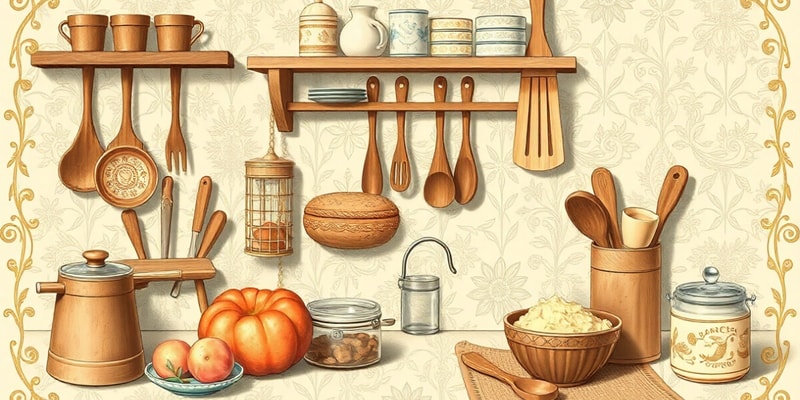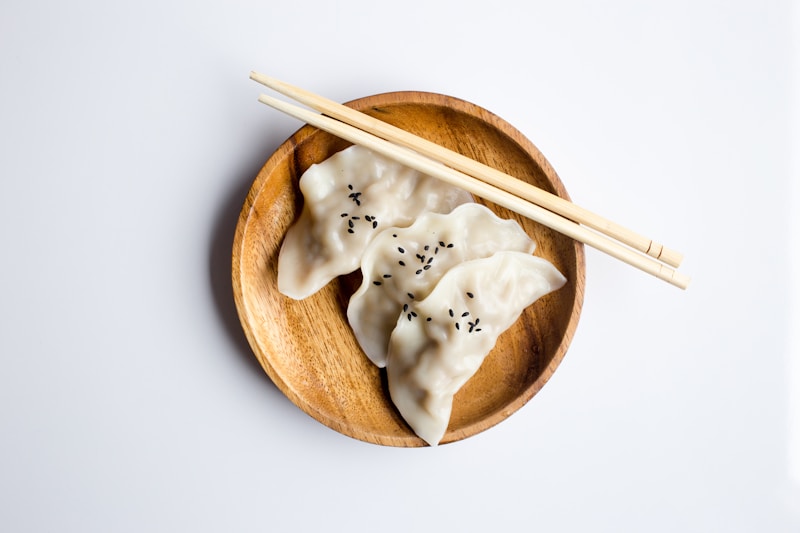Podcast
Questions and Answers
What is the primary benefit of using a programming language?
What is the primary benefit of using a programming language?
All programming languages are designed for the same purpose.
All programming languages are designed for the same purpose.
False
What do you call the process of finding and fixing errors in a program?
What do you call the process of finding and fixing errors in a program?
Debugging
In object-oriented programming, a class is a blueprint for creating __________.
In object-oriented programming, a class is a blueprint for creating __________.
Signup and view all the answers
Match the following programming concepts with their definitions:
Match the following programming concepts with their definitions:
Signup and view all the answers
Study Notes
Kitchen Tools and Equipment
- Cleaning and sanitizing procedures are crucial parts of food safety programs.
- Improperly cleaned surfaces can spread harmful microorganisms to food.
Cooking Materials
-
Aluminum: Common in kitchens due to its lightweight, attractive appearance, and affordability. It needs care to stay clean and shiny. It distributes heat evenly at various temperatures. Thinner gauges are more prone to dents and scratches. It reacts with alkaline substances (like potatoes, beets, and carrots), turning them dark, while acid substances (like tomatoes) brighten it.
-
Stainless Steel: A popular material for kitchen tools & equipment, but more expensive than aluminum. It's easy to clean, maintain shine, and resists wear.
-
Glass: Used for dishes and containers for salad and desserts, but not ideal for top-surface cooking. Requires careful handling to avoid breakage. Special cleaning techniques should be used to ensure long shelf life. Removing stains involves soaking with bleach and using baking soda followed by vinegar as a final rinse.
-
Cast Iron: Durable, but requires oiling to prevent rusting. Salad oil, without salt or shortening, is useful for this. Wash with soap, not detergent, before use.
-
Double Boiler: Useful for maintaining temperatures below boiling—for example, egg sauces, puddings, and keeping food warm without overcooking.
-
Teflon: A special coating applied to aluminum or steel that prevents food from sticking. Care must be taken not to scratch the coating. Use wooden or plastic utensils.
Kitchen Tools
-
Cans, Bottles, Cartoons Opener: Opens containers easily and comfortably.
-
Colanders (Vegetable Strainers): Essential for cleaning vegetables and straining pasta or other contents.
-
Plastic and Hard Rubber: Used for cutting boards, tabletops, bowls, trays, garbage pails, and canisters. Less likely to dull knives and more sanitary than wood. Plastics are durable and inexpensive.
-
Cutting Boards: (Wooden or plastic) Used for cutting meat, fruits, and vegetables
-
Funnels: Used to fill jars. Various sizes, made of stainless steel, aluminum, or plastic..
-
Garlic Press: A kitchen tool uniquely designed to crush garlic.
-
Graters: Used for grating, shredding, slicing, and separating foods. Useful for carrots, cabbage, and cheese.
-
Kitchen Shears: Useful for opening packages, cutting tape or string, and removing labels.
-
Potato Masher: Used for mashing cooked potatoes, turnips, carrots, and other soft cooked vegetables.
-
Rotary Egg Beater: Used for beating small amounts of eggs or batter. Made of stainless steel.
-
Scraper: A rubber or silicone tool to mix or scrape food from bowls, metal, silicone or plastic egg turners, or flippers.
-
Serving Spoons: Utensils with a small shallow bowl on a handle, used for preparing, serving, or eating food.
-
Serving Tongs: Used to grab and transfer larger items like poultry or meat to platters or plates, especially when using a deep fryer or large pot.
-
Spatula: Used for leveling ingredients, spreading frostings, and sandwich fillings.
-
Spoons: Solid, slotted, or perforated spoons, made of steel or plastic, used for scooping liquids and lifting food from the pot, including scooping or lifting liquids from pots.
Temperature Scales
-
Used to measure heat intensity. Different thermometers are for different foods or purposes, like checking meat, candies, frying foods, and keeping ovens and refrigerators at the correct temperatures.
-
Whisks: Used for blending, mixing, whipping eggs, batter, gravies, sauces, soups. The beaters are made from looped steel piano wires.
-
Wooden Spoons: Used for creaming, stirring, and mixing. Made of hard wood.
Measuring Tools
-
Measuring Cup for Liquid Ingredients: Often heat-proof glass and transparent—useful for seeing contents to accurately measure liquids.
-
Household Scales: Weighs large quantities, common with rice, flour, sugar, legumes, or vegetables. Range from small to large models often measuring up to 25 lbs.
-
Scoops (or Dippers): Used for measuring soft foods like fillings, ice cream, and mashed potatoes. Available in various sizes, shapes, materials, and colors.
Kinds of Knives
-
Fruit and Salad Knife: Used for preparing fruits and vegetables.
-
French Knife: Used for chopping, dicing, and mincing food. Heavy knives often have flat grinds.
-
Citrus Knife: Features a two-sided blade and serrated edge for sectioning citrus fruits.
-
Kitchen Knives: Versatile tools for tasks like peeling onions, slicing carrots, or carving roast/turkey.
-
Paring Knife: Used for coring, peeling, and sectioning fruit and vegetables. Short blades and concave, hollow grinds.
-
Vegetable Peeler: Used to scrape vegetables like carrots and potatoes and peel fruits. Sharp double-bladed designs that swivel are common.
Other Equipment
- Equipment: Electrical appliances or larger equipment like mixers, ovens, refrigerators, ranges, and microwaves. These are essential to any kitchen establishment.
Refrigerators/Freezers
-
Essential for preventing bacterial contamination from food. Modern design often includes compartments for various types of foods—meat, fruits, and vegetables—keeping moisture at optimal levels. Butter compartments separate butter from odors that spoil flavor.
-
Insulated boxes ensure internal temperatures needed for safe food storage.
-
Ovens: Chambers/compartments used for cooking, baking, heating, or drying.
-
Microwave Ovens: Used for cooking or heating food.
-
Blenders: Used to chop, blend, mix, whip, puree, grate, and liquefy all kinds of food. vary in power output (voltage/wattage)
Cleaning
- Cleaning involves removing food, soil, or other substances from surfaces.
- The right cleaning agent for food-contact surfaces must be used.
- Glass/metal cleaners, for example, might leave unsafe residues on food surfaces and are therefore not suitable.
- Cleaning labels should specify if a product can be used for food-contact surfaces. The correct cleaning agents make the process manageable.
Cleaning Compounds
-
Detergents: Cleaning agents, solvents, various substances used for cleaning tableware, surfaces, and equipment (soap, powdered soap, cleaners, acids, volatile solvents, abrasives).
-
Solvent Cleaners: Degreasers specifically designed to remove grease build-up in ovens and grills; these products are alkaline-based and formulated to dissolve grease.
-
Acid Cleaners: Used to eliminate mineral deposits (scale), lime buildup, and rust from washing machines, steam tables, and dishwashers.
-
Abrasives: Used for heavy, tough soil removal. These are typically only used when other cleaning agents aren't effective enough.
-
Other Chemicals: Additional chemicals (e.g., ammonia, dishwashing liquids, chlorine, carbolic acid, deodorizer, disinfectants, soap) are used for cleaning and/or sanitizing kitchens.
Studying That Suits You
Use AI to generate personalized quizzes and flashcards to suit your learning preferences.
Related Documents
Description
This quiz explores essential kitchen tools and equipment, focusing on materials like aluminum, stainless steel, and glass. It discusses their properties, cleaning procedures, and importance in food safety. Test your knowledge of effective kitchen practices now!




